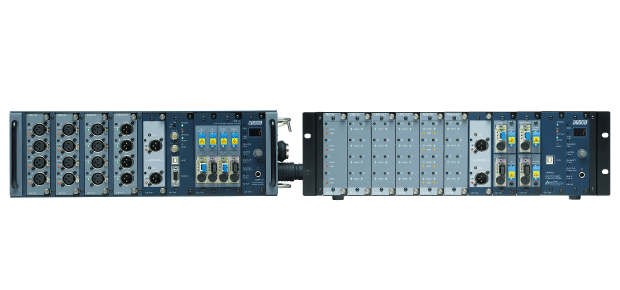| LWB-16M/64 Optical Wiring System |
FAQ |  | - What do you mean by the terms “OPTICAL UP” and “OPTICAL DOWN”?
These are port labels applied to facilitate connection of optical fibers: the two neighboring LWB units are always connected together from the UP to DOWN connectors. Note that AC power is always output from the OPTICAL UP receptacle and received at the OPTICAL DOWN receptacle on the next unit. - What is the usage of the switch next to the AC inlet?
When you are sending AC power from the OPTICAL UP receptacle from one LWB unit to the next (upstream) one via the fiber-optic camera cable, this switch is used to select whether to send the AC power supplied from the downstream unit via the camera cable to the OPTICAL DOWN receptacle (OPTICAL DOWN) or to send the AC power fed to the AC inlet on this unit (AC INLET). - What is the usage of the XLR connectors next to the OPTICAL UP and DOWN receptacles?
In addition to the power lines, the hybrid fiber-optic camera cable contains two copper wires called control lines. The XLR connectors next to the OPTICAL UP and DOWN receptacles are internally connected to these control lines. You can use these connectors as the final backup lines to connect line level analog audio signals or analog intercom signals. - Can I select male/female type of XLR connectors?
Yes. For the LINE IN, LINE OUT, MIC IN, 2-WIRE INTERCOM, 4-WIRE INTERCOM and AES3 IN/OUT modules, you can specify male/female type of XLR connectors when ordering. - Can each I/O module be used on both the LWB-16M and LWB-64?
The following I/O modules for the LWB-16M can also be used on the LWB-64. Note that the I/O modules for the LWB-64 cannot be used on the LWB-16M. - 4ch MIC IN: CB-7AZ
- 4ch LINE IN: CB-7AX
- 4ch AES3 IN: CB-7BA
- 4ch LINE OUT: CB-7AY
- 4ch AES3 OUT: CB-7BB
- 2ch AES3 IN/OUT: CB-7BR
- 2-WIRE INTERCOM (single ch): CB-79P
- 2-WIRE INTERCOM (dual/single ch): CB-7BM
- 4-WIRE INTERCOM: CB-7BN
- What is the reference level for the analog audio interface?
You can select from +24 dBu, +22 dBu and +20 dBu for digital level 0 dBFS (-20 dBFS, -18 dBFS and -16 dBFS for analog level +4 dBu) using jumper sockets on the PC board). - What is the amount of attenuation of the pad amplifier in the MIC IN module?
-25 dB. - How are video signals transmitted simultaneously with audio signals?
By adopting the Wavelength Division Multiplexing (WDM) technology, one optical fiber can send two optical signals having different wave lengths. The LWB-16M/64 uses a 1310-nm optical signal for audio and 1551 nm optical signal for video. These two optical signals are multiplexed by using a passive component called a WDM coupler and then transmitted via the optical fiber. - What is the standard of the supported video signal?
The LWB-16M/64 supports SD-SDI (Standard Definition - Serial Digital Interface/SMPTE 259M) and HD-SDI (High Definition - Serial Digital Interface/SMPTE 292M) but it does not support format conversion between SD-SDI and HD-SDI. Transmission of analog composite video signals is not supported.
NOTE: Since HD-SDI is a very high-speed signal, cable manufacturers usually specify to use coax cables that support HD-SDI. Usual 75-ohm coax cables sometimes cannot convey HDSDI signals even though they can transfer analog video signals. - How many video channels can the LWB system transmit?
With the LWB-16M/64’s transmission method using WDM, one optical fiber can send one channel of video signals. Since the fiber-optic camera cable contains two optical fiber lines, two channels of video signals can be transferred via one camera cable. - How do the two XLR connectors on the 2-wire intercom module operate when in dual channel mode?
In dual channel mode, the same two-channel intercom signal can be obtained from the two XLR connectors. - Are there any limits in routing of intercom lines?
You can create up to 12 independent party lines and you can set a maximum of eight intercom channels for one party line. - Can I lock out the switches on the unit?
Yes. This function is provided in Extended Setup mode. When in the key lockout status, operators cannot change each parameter value but can still confirm the current setting. - Are the settings such as audio routing stored in the system?
Yes. In addition to the routing information, +48-V power on/off, pad on/off, limiter on/off and gain value of the MIC IN module as well as SRC on/off of the AES3(id) IN module are stored in the nonvolatile memory in the LWB-16M/64. So when the LWB unit is powered on, it starts operation based on the stored settings.
What is stored is the current settings only: this is not a snapshot function that can store/recall multiple patterns of setup. - If, after hot-unplugging a module, I hot-plug the same (type) module, will the previous settings be restored?
Yes. The settings before hot-unplugging are restored. - Can I get AC power from the LWB unit powered via the hybrid fiber-optic camera cable?
No. But you can add an AC outlet to the rear panel (LWB-64) or side panel (LWB-16M) as a special order. Note that output current is limited to 3 A.
|
|
 home
home home
home